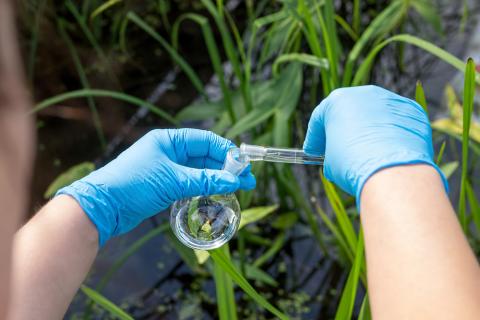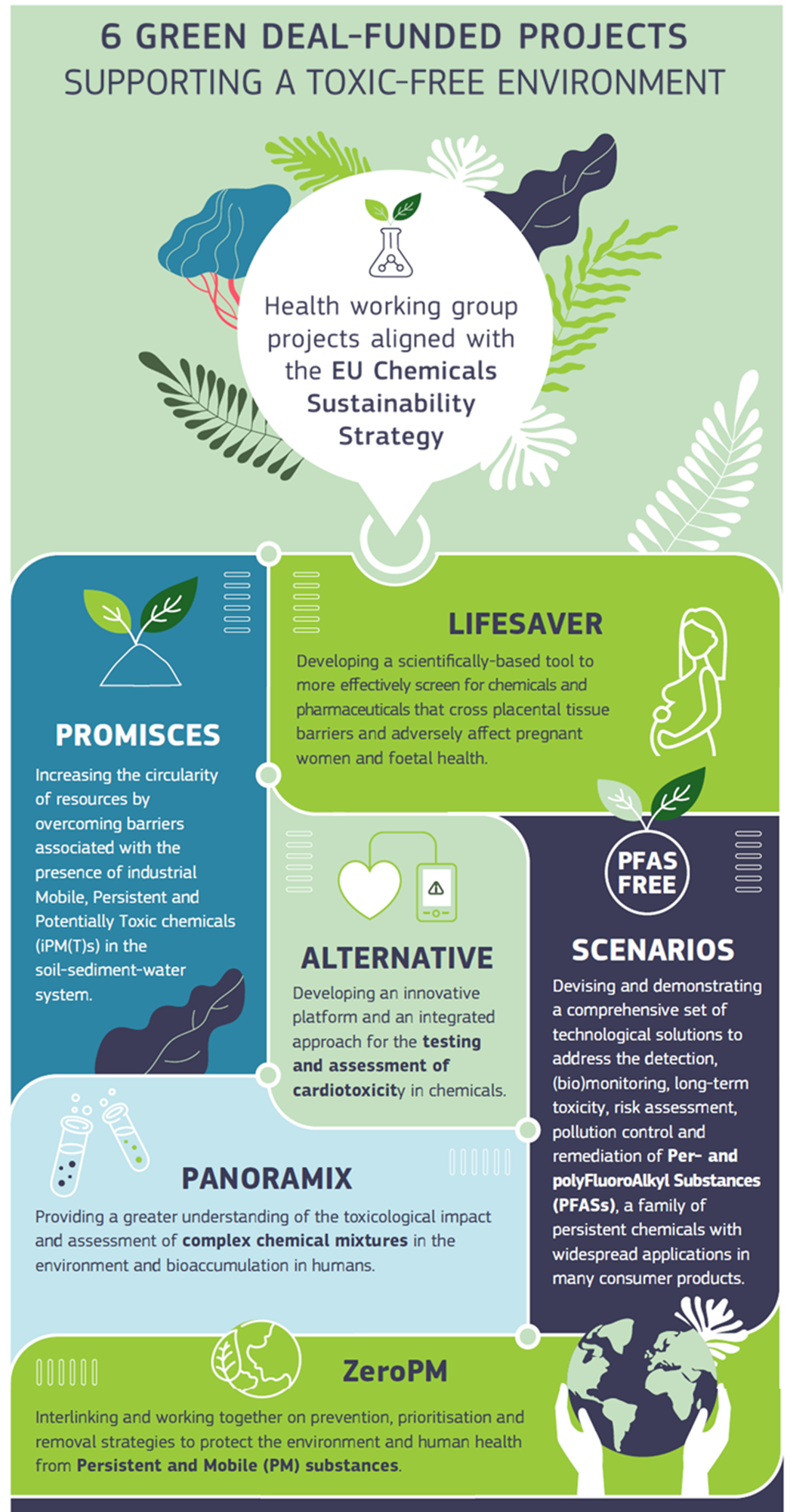Details
- Publication date
- Source
- Green Deal Projects Support Office
From the moment we wake up and even through the night as we sleep peacefully, our lives are intertwined with countless products and substances. Many of these are laden with synthetic chemicals and only some of which perform essential functions (e.g. as a fire retardant bedding). Alarming as it may be an increasing number of these chemicals have been deemed unsafe for human exposure. They can seep into our bodies through various means—be it through drinking water, food, inhalation, or even contact with our skin—leading to immediate or long-term effects that can significantly impact our well-being and health.
The consequences of exposure to toxins on human and environmental health are far-reaching, encompassing a range of adverse outcomes. Chemicals such as endocrine disruptors, carcinogens, and neurotoxicants have been linked to developmental disorders, reproductive issues, cancers, and respiratory ailments. The gravity of the situation cannot be ignored, which is why it is crucial to shine a spotlight on the key policy frameworks in the European Union (EU) ), and the research that underpins them, that are paving the way towards mitigating these risks. Moreover, we will explore a group of extraordinary Green Deal projects that complements these aims, bringing us closer to a safer and healthier future, and shine a spotlight on one in particular.
The EU's Chemical Strategy: 'Towards a Toxic-Free Environment'
Recognising the urgency of the matter of human and environmental exposure to potentially toxic chemicals, the European Union has taken a proactive stance by implementing its Chemicals Strategy for Sustainability (CSS). At its core, the CSS seeks to create an environment free from toxicity, ensuring the good health and well-being of both humans and the planet. It sets out to revolutionise the EU's chemical policies, enhance the protection of human health and the environment, and facilitate the transition to safer alternatives.
Central to the strategy is the shift from a substance-by-substance hazard-based approach to a comprehensive risk management approach. A hazard-based approach regulates substances on the basis of their intrinsically hazardous properties. It does not take into account the amount of exposure to the substance, whereas a risk-based approach does. Taking a risk-based approach places greater emphasis on assessing and managing the risks of the chemical in use and relies on the deployment of checks and measures to keep these risks below acceptable levels.
Through a combination of regulatory measures, innovation incentives, and increased transparency, the EU aims to guarantee the safe use of chemicals throughout their entire lifecycle. Key actions of the strategy include:
- strengthening the authorisation and risk assessment processes for chemicals;
- enhancing the substitution of hazardous substances with safer alternatives;
- promoting the circular economy to minimise waste and facilitate recycling;
- improving the dissemination of information on chemical hazards; and
- emphasising the importance of supporting research and innovation for developing safer and more sustainable chemicals.
By implementing these measures, the EU aims to reduce exposure to harmful substances, protect human health, and foster the development of greener industries.
Complementary policies: REACH and the Restrictions Roadmap
In the pursuit of a toxic-free environment, the EU's REACH (Registration, Evaluation, Authorisation, and Restriction of Chemicals) regulation, which came into force in 2007, plays a pivotal role in complementing the CSS. REACH is designed to ensure a high level of protection for human health and the environment by placing the burden of proof on industries to demonstrate the safety of their chemicals. Companies are required to register their substances with the European Chemicals Agency (ECHA), providing comprehensive information on their properties and safe use, with the amount of information required scaling with the amount of the chemical produced. This registration process enables authorities to assess potential risks associated with these chemicals and to take appropriate regulatory actions, if necessary.
Similarly, the EU's Restrictions Roadmap closely aligns with the goal of the CSS and serves as a comprehensive plan to implement the strictest-ever restrictions on hazardous substances in the EU. This roadmap outlines a series of actions to identify and address substances of concern based on their hazardous properties and potential risks. It involves a step-by-step approach to assess and restrict the use of specific chemicals that pose significant risks to human health and the environment. These restrictions can include limitations on the manufacture, placing on the market, or use of these substances.
The EU aims to address priority substances systematically and effectively by implementing the Restrictions Roadmap. This approach ensures that hazardous chemicals are phased out or their use is significantly reduced, promoting the transition to safer alternatives. The roadmap targets substances of high concern, including those classified as carcinogens, mutagens, or reproductive toxicants, endocrine disruptors, as well as substances with the following properties:
PBT = persistent, bioaccumulative, and toxic
vPvT = very persistent and very bioaccumulative (vPvB)
PMT = persistent, mobile and toxic
vPvM = very persistent and very mobile (vPvM)
In this context, “mobile” typically refers to the ability of these pollutants to be able to travel in water.
PMT and vPvM substances are particularly significant as they are explicitly referred to in the CSS and are the focus of three out of the six sister projects (see table below).
Both REACH and the Restrictions Roadmap's integration with the Chemical Strategy is vital for achieving the objective of creating a toxic-free environment. They complement the broader goals and actions outlined in the Chemical Strategy and demonstrate the EU's commitment to taking decisive steps towards reducing the risks associated with hazardous chemicals and ensuring the protection of human health and the environment.
Green Deal projects aligned with the CSS
But beyond the regulatory landscape, several Green Deal projects are actively involved in furthering research and understanding of chemical exposures and zero-pollution solutions. For example, the LifeSaver project has produced a series of blog posts exploring the impact of environmental pollutants such as microplastics on pregnant women and foetuses by breaching the placental barrier.
The infographic below summarises six sister projects and how their objectives align with the CSS.
Infographic of health projects supporting the EU's Chemicals Sustainability Strategy
This cluster of projects collaborate with one another to exchange knowledge and best practices as well as to increase their reach within specialised audiences. Examples include:
• Delivering joint events such as recent webinars on 3D models for in-vitro toxicology studies (ALTERNATIVE and Lifesaver), and models for toxicology (ALTERNATIVE and PANORAMIX) aimed at regulators, researchers and industry to initiate dialogue on their requirements from the projects and to advance the knowledge of modelling in this area.
• Participating in each others’ events to exchange knowledge through active discussions.
• Disseminating communications through each others’ networks such as the distribution of a recent survey to gather input on PMT substances.
• Monitoring policy updates to develop a mutual understanding of the policy context and regulatory framework to which their outcomes will contribute. Specifically, supporting each other in obtaining information on policy updates, such as the status of Green Deal policies to increase awareness of the need for feedback. ZeroPM project has already adapted this approach through their regulatory watch.
• Developing joint policy briefs to maximise the impact of their results.
• Reaching out to policy and decision-makers to ensure that the projects’ research and policy recommendations are considered in decision-making processes.
Project spotlight: ZeroPM
ZeroPM is an exemplary project at the forefront of the Green Deal's ambitious objectives and working towards the realisation of the Chemical Strategy's ambitions. With a comprehensive approach that combines cutting-edge research, innovation, and collaborative partnerships, the overarching aim of ZeroPM is to establish an evidence-based multilevel framework for minimising use, emissions and pollution from persistent and mobile substances to protect European water resources and avoid risks to humans. These substances, known for their longevity in the environment and ability to travel vast distances in the aquatic environment, pose significant risks to ecosystems and human health. The diagram below illustrates how ZeroPM links Prevention, Prioritisation and Removal strategies, inspired by the toxic-free hierarchy presented in the Chemicals Strategy:
ZeroPM links with Prevention, Prioritisation and Removal strategies. Source: ZeroPM
Prevention solutions offer the most direct and effective means to minimise both the exposure and societal costs associated with persistent and mobile substance pollution. By restricting the usage of such substances, the risks linked to their exposure and removal are effectively eliminated.
Last year, ZeroPM hosted a ground-breaking webinar that delved into the concept of safe and sustainable by design (SSbD), a key preventative approach introduced in the Chemical Strategy. During the webinar, keynote speakers Xenia Trier from the University of Copenhagen and Zhanyun Wang from EMPA, shed light on creating an enabling environment for SSbD and fostering the transition towards this paradigm. Earlier this year, a prevention workshop was hosted in Sweden as an opportunity to interact with experts and authorities on prevention through chemical alternatives, policy action and market transition.
Prioritisation is also fundamental to ZeroPM’s approach. Identifying and prioritising substances of the highest concern based on their hazardous properties and potential risks ensures that efforts are focused on tackling the most pressing issues.
The project assesses the impact of these substances on water resources and human health through a systematic and science-based approach allowing for effective decision-making and targeted actions. ZeroPM's prioritisation strategy ensures that resources are allocated efficiently, enabling the project to significantly reduce pollution and safeguard the environment.
This then leads to their Removal strategy, which develops innovative approaches and technologies to eliminate the presence of these substances in the environment. Efficient removal techniques include advanced filtration, adsorption, and degradation methods, depending on the specific pollutant. One such example is the removal of PFAS at the Mytilene wastewater treatment plant. The Removal strategy is instrumental in achieving the project's goal of creating a toxic-free environment and promoting sustainable remediation practices for the benefit of current and future generations. By implementing prevention, prioritisation and removal strategies, ZeroPM strives to prevent further contamination, restore polluted areas, and ensure the long-term protection of water resources.
ZeroPM serves as a pioneering project that bridges the gap between policy and action, transforming the aspirations of the Chemicals Strategy into a tangible reality. It plays a pivotal role in supporting the movement towards a zero-pollution, toxic-free environment. For more information on other remarkable Green Deal projects focused on minimising toxic chemical exposures, we invite you to visit the Food and Health Working Group projects.
Together, the EU's Chemical Strategy, its complementary frameworks including REACH and the Restrictions Roadmap, and transformative projects like ZeroPM, PROMISCES, SCENARIOS and LifeSaver form a powerful force in the fight against toxic chemical exposure. By prioritising human health and environmental protection, fostering innovation, and encouraging sustainable alternatives, these initiatives bring us closer to a future where we can thrive without compromising our well-being. It is through such collaborative efforts that we can pave the way for a safer, healthier, and more sustainable world for generations to come.
Find out more about the Green Deal-funded health projects:
• ALTERNATIVE Project overview | Project website
• LifeSaver Project overview | Project website
• PANORAMIX Project overview | Project website
• PROMISCES: Project overview | Project website
• SCENARIOS Project overview | Project website
• ZeroPM Project overview | Project website
More information about the Food and Health Working Group of the Green Deal Projects Support Office:




